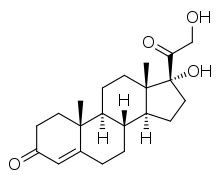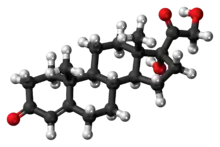11-Deoxycortisol
 | |
 | |
| Names | |
|---|---|
| Preferred IUPAC name
(1R,3aS,3bR,9aR,9bS,11aS)-1-Hydroxy-1-(2-hydroxy-1-oxoethyl)-9a,11a-dimethyl-1,2,3,3a,3b,4,5,8,9,9a,9b,10,11,11a-tetradecahydro-7H-cyclopenta[a]phenanthren-7-one | |
| Other names
11-Deoxycortisol; 11-Deoxycortisone; Cortoxelone; 17α,21-Dihydroxypregn-4-ene-3,20-dione; 17α,21-Dihydroxyprogesterone; 11-Desoxycortisol; 11-Deoxyhydrocortisone; 11-Desoxyhydrocortisone; 17α-Hydroxy-11-deoxycorticosterone; Reichstein's Substance S; Compound S; Cortodoxone; Cortexolone, | |
| Identifiers | |
CAS Number |
|
3D model (JSmol) |
|
| ChEBI | |
| ChEMBL | |
| ChemSpider | |
| ECHA InfoCard | 100.005.279 |
| KEGG | |
PubChem CID |
|
| UNII | |
CompTox Dashboard (EPA) |
|
InChI
| |
SMILES
| |
| Properties | |
Chemical formula |
C21H30O4 |
| Molar mass | 346.467 g·mol−1 |
| Melting point | 215 °C (419 °F; 488 K) |
Except where otherwise noted, data are given for materials in their standard state (at 25 °C [77 °F], 100 kPa). | |
| Infobox references | |
11-Deoxycortisol, also known as cortodoxone (INN), cortexolone[1][2][3][4] as well as 17α,21-dihydroxyprogesterone or 17α,21-dihydroxypregn-4-ene-3,20-dione,[5] is an endogenous glucocorticoid steroid hormone, and a metabolic intermediate towards cortisol. It was first described by Tadeusz Reichstein in 1938 as Substance S,[6] thus has also been referred to as Reichstein's Substance S[5] or Compound S.[7][8]
Function

11-Deoxycortisol acts as a glucocorticoid, though is less potent than cortisol.[10]
11-Deoxycortisol is synthesized from 17α-hydroxyprogesterone by 21-hydroxylase and is converted to cortisol by 11β-hydroxylase.
11-Deoxycortisol in mammals has limited biological activity and mainly acts as metabolic intermediate within the glucocorticoid pathway, leading to cortisol.[11] In sea lamprey, a member of the agnathans that evolved more than 500 million years ago, 11-deoxycortisol is the major and final glucocorticoid, with mineralocorticoid activity. 11-deoxycortisol also takes part, by binding to specific corticosteroid receptors, in intestinal osmoregulation in sea lamprey at metamorphosis, during which they develop seawater tolerance before downstream migration.[12] Sea lamprey do not have 11β-hydroxylase enzyme (CYP11B1) that converts 11-deoxycortisol to cortisol and 11-deoxycorticosterone to corticosterone in mammals. This indicates that a complex and highly specific corticosteroid signaling pathway evolved at least 500 million years ago with the arrival of the earliest vertebrate.[13] The absence of cortisol and corticosterone in sea lampreys suggests that the 11β-hydroxylase enzyme may not have been present early in vertebrate evolution.[14]
Clinical significance
11-Deoxycortisol in mammals has limited glucocorticoid activity, but it is the direct precursor of the major mammalian glucocorticoid, cortisol.[15] As a result, the level of 11-deoxycortisol is measured to diagnose impaired cortisol synthesis, to find out the enzyme deficiency that causes impairment along the pathway to cortisol, and to differentiate adrenal disorders.[16]
In 11β-hydroxylase deficiency, 11-deoxycortisol and 11-deoxycorticosterone levels increase, and excess of 11-deoxycorticosterone leads to mineralocorticoid-based hypertension[17] (as opposed to 21-hydroxylase deficiency, in which patients have low blood pressure from a lack of mineralocorticoids). In 11β-hydroxylase deficiency, 11-deoxycortisol can also be converted to androstenedione in a pathway that could explain the increase in androstenedione levels this condition.[18]
In 21-hydroxylase deficiency, 11-deoxycortisol levels are low.[19]
History
In 1934, biochemist Tadeus Reichstein, working in Switzerland, began research on extracts from animal adrenal glands in order to isolate physiologically active compounds.[20] He was publishing results of his findings along the way. By 1944, he already isolated and elucidated the chemical structure of 29 pure substances.[21] He was assigning names that consisted of the word "Substance" and a letter from the Latin alphabet to the newly found substances. In 1938, he has published an article about "Substance R" and "Substance S" describing their chemical structures and properties.[6] The Substance S since about 1955 became known as 11-Deoxycortisol.[22]
In the 1930s and 1940s clinicians were discovering many uses for the newly discovered hormones, however, only minute quantities could be extracted from animal organs. Chemists were looking for production of these hormones on a larger industrial scale.
In 1949, American research chemist Percy Lavon Julian, in looking for ways to produce cortisone, announced the synthesis of the Compound S, from the cheap and readily available pregnenolone (synthesized from the soybean oil sterol stigmasterol).[23][24]
On April 5, 1952, biochemist Durey Peterson and microbiologist Herbert Murray at Upjohn, published the first report of a breakthrough fermentation process for the microbial 11α-oxygenation of steroids (e.g. progesterone) in a single step by common molds of the order Mucorales.[25] 11α-oxygenation of Compound S produces 11α-hydrocortisone, which can be chemically oxidized to cortisone, or converted by further chemical steps to 11β-hydrocortisone (cortisol).
See also
- 11-Deoxycorticosterone
- Cortexolone 17α-propionate
References
- ↑ Rosette C, Agan FJ, Rosette N, Mazzetti A, Moro L, Gerloni M (August 2020). "The dual androgen receptor and glucocorticoid receptor antagonist CB-03-10 as potential treatment for tumors that have acquired GR-mediated resistance to AR blockade". Molecular Cancer Therapeutics. 19 (11): 2256–2266. doi:10.1158/1535-7163.MCT-19-1137. PMID 32847976. S2CID 221345484.
- ↑ Iaderets VV, Andriushina VA, Bartoshevich IE, Domracheva AG, Novak MI, Stytsenko TS, Voĭshvillo NE (2007). "[A study of steroid hydroxylation activity of Curvularia lunata mycelium]". Prikladnaia Biokhimiia I Mikrobiologiia (in Russian). 43 (6): 695–700. PMID 18173113.
- ↑ Manosroi J, Chisti Y, Manosroi A (2006). "Biotransformation of cortexolone to hydrocortisone by molds using a rapid color development assay". Prikladnaia Biokhimiia I Mikrobiologiia. 42 (5): 547–51. PMID 17066954.
- ↑ Lisowska K, Długoński J (May 2003). "Concurrent corticosteroid and phenanthrene transformation by filamentous fungus Cunninghamella elegans". The Journal of Steroid Biochemistry and Molecular Biology. 85 (1): 63–9. doi:10.1016/s0960-0760(03)00136-5. PMID 12798358. S2CID 384672.
- 1 2 R.A. Hill; H.L.J. Makin; D.N. Kirk; G.M. Murphy (23 May 1991). Dictionary of Steroids. CRC Press. pp. 338–. ISBN 978-0-412-27060-4.
- 1 2 Reichstein, T. (1938). "Über Bestandteile der Nebennierenrinde. 21. Mitteilung. Die Konstitution der Substanzen R und S". Helvetica Chimica Acta. 21: 1490–1497. doi:10.1002/hlca.193802101183.
- ↑ Wudy SA, Hartmann M, Homoki J (September 2002). "Determination of 11-deoxycortisol (Reichstein's compound S) in human plasma by clinical isotope dilution mass spectrometry using benchtop gas chromatography-mass selective detection". Steroids. 67 (10): 851–7. doi:10.1016/s0039-128x(02)00052-1. PMID 12231120. S2CID 29970823.
- ↑ Berneis K, Staub JJ, Gessler A, Meier C, Girard J, Müller B (December 2002). "Combined stimulation of adrenocorticotropin and compound-S by single dose metyrapone test as an outpatient procedure to assess hypothalamic-pituitary-adrenal function". The Journal of Clinical Endocrinology and Metabolism. 87 (12): 5470–5. doi:10.1210/jc.2001-011959. PMID 12466339.
- ↑ Häggström M, Richfield D (2014). "Diagram of the pathways of human steroidogenesis". WikiJournal of Medicine. 1 (1). doi:10.15347/wjm/2014.005. ISSN 2002-4436.
- ↑ Engels M, Pijnenburg-Kleizen KJ, Utari A, Faradz SM, Oude-Alink S, van Herwaarden AE, Span PN, Sweep FC, Claahsen-van der Grinten HL (November 2019). "Glucocorticoid Activity of Adrenal Steroid Precursors in Untreated Patients With Congenital Adrenal Hyperplasia". The Journal of Clinical Endocrinology and Metabolism. 104 (11): 5065–5072. doi:10.1210/jc.2019-00547. PMID 31090904.
- ↑ "Congenital Adrenal Hyperplasia Caused by 11Beta-Hydroxylase Deficiency".
- ↑ Barany A, Shaughnessy CA, McCormick SD (March 2021). "Corticosteroid control of Na+/K+-ATPase in the intestine of the sea lamprey (Petromyzon marinus)". General and Comparative Endocrinology. 307: 113756. doi:10.1016/j.ygcen.2021.113756. PMID 33741310. S2CID 232296805.
- ↑ Shaughnessy CA, Barany A, McCormick SD (July 2020). "11-Deoxycortisol controls hydromineral balance in the most basal osmoregulating vertebrate, sea lamprey (Petromyzon marinus)". Scientific Reports. 10 (1): 12148. Bibcode:2020NatSR..1012148S. doi:10.1038/s41598-020-69061-4. PMC 7376053. PMID 32699304.
- ↑ Close DA, Yun SS, McCormick SD, Wildbill AJ, Li W (August 2010). "11-deoxycortisol is a corticosteroid hormone in the lamprey". Proceedings of the National Academy of Sciences of the United States of America. 107 (31): 13942–7. Bibcode:2010PNAS..10713942C. doi:10.1073/pnas.0914026107. PMC 2922276. PMID 20643930.
- ↑ Zöllner A, Kagawa N, Waterman MR, Nonaka Y, Takio K, Shiro Y, Hannemann F, Bernhardt R (February 2008). "Purification and functional characterization of human 11beta hydroxylase expressed in Escherichia coli". The FEBS Journal. 275 (4): 799–810. doi:10.1111/j.1742-4658.2008.06253.x. PMID 18215163. S2CID 45997341.
- ↑ "Serum steroid levels can help differentiate adrenal disorders".
- ↑ Gupta V (October 2011). "Mineralocorticoid hypertension". Indian Journal of Endocrinology and Metabolism. 15 Suppl 4 (8): S298–312. doi:10.4103/2230-8210.86972. PMC 3230101. PMID 22145132.
- ↑ Auzéby A, Bogdan A, Touitou Y (January 1991). "Evidence for a new biologic pathway of androstenedione synthesis from 11-deoxycortisol". Steroids. 56 (1): 33–6. doi:10.1016/0039-128X(91)90112-9. PMID 2028480. S2CID 6261965.
- ↑ C.R. Kannan (2013). Essential Endocrinology: A Primer for Nonspecialists. Springer Science & Business Media. p. 263. ISBN 9781489916921.
- ↑ "Chemistry of the Adrenal Cortex Hormones".
- ↑ Grzybowski A, Pietrzak K (2012). "Tadeusz Reichstein (1897-1996): a cofounder of modern steroid treatment in dermatology". Clinics in Dermatology. 30 (2): 243–7. doi:10.1016/j.clindermatol.2011.09.003. PMID 22435119.
- ↑ Forchielli E, Rosenkrantz H, Dorfman RI (1 August 1955). "Metabolism of 11-deoxycortisol in vitro". The Journal of Biological Chemistry. 215 (2): 713–22. doi:10.1016/S0021-9258(18)65996-4. PMID 13242571.
- ↑ Gibbons, Roy (September 30, 1949). "Science gets synthetic key to rare drug; discovery is made in Chicago". Chicago Tribune. p. 1.
Dr. Julian's new method for synthesizing the anti-arthritis compound, cortisone, is less costly than present methods, because it eliminates the need for utilizing osmium tetroxide, a rare and expensive chemical, the Glidden company declared....But whether has Dr. Julian has also synthesized cortisone from soybeans neither he nor the Glidden company would reveal.
- ↑ "News of the week: New cortisone synthesis". Chemical & Engineering News. 27 (41): 2936–2942. October 10, 1949. doi:10.1021/cen-v027n041.p2936.
Quote: A new synthesis of cortisone, eliminating the need for expensive osmium tetroxide, and the synthesis of three other compounds related to cortisone, which may possible be useful in the treatment of arthritis, have been announced by Percy L. Julian, director of research of the soya products division of the Glidden Co., Chicago. No statement was made as to further details of the new synthesis, but it was revealed that soybean products were not involved...all three [other compounds] were made from soybean sterols.
- ↑ Peterson DH; Murray, HC (1952). "Microbiological oxygenation of steroids at carbon 11". J Am Chem Soc. 74 (7): 1871–2. doi:10.1021/ja01127a531.